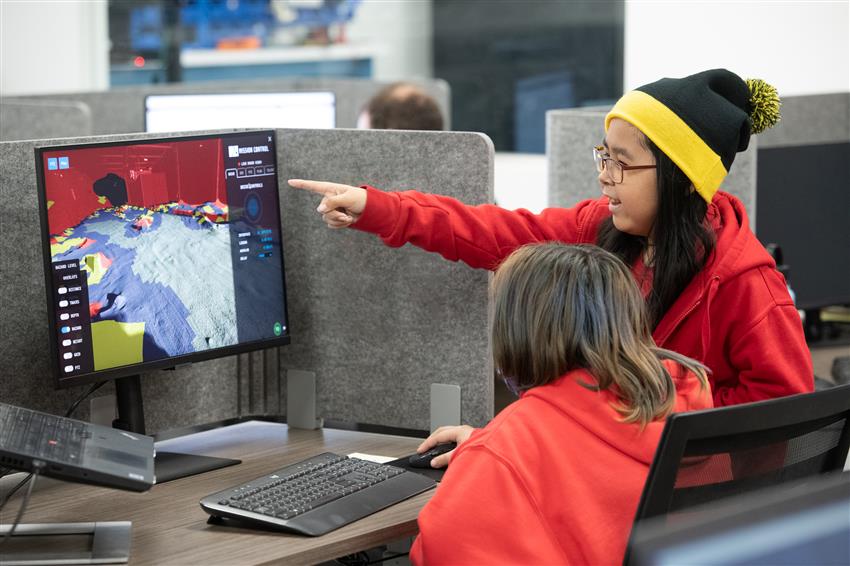Learning experience that turns students into lunar rover drivers
Imagine yourself driving a rover that is exploring the Moon… Suddenly, you reach a crater that is particularly steep. You need to reach the other side to collect rock samples that will be studied by scientists on Earth for decades. Do you cross the crater? Go around it? And how will you select the rocks with the best scientific yield?
The Rover Driving Academy
Over 18 months, nearly 4500 Canadian students from all provinces and territories had the opportunity to take part in a rover mission as they remotely operated a lunar rover in a simulated, yet very realistic, Moon landscape located at Mission Control's facility in Ottawa. Students could play different roles, such as rover driver, navigator, camera operator, safety guardian, communicator or scientist. This helped them gain an appreciation of the variety of technology and operator skills that are required to conduct a successful rover mission on the Moon, 384,000 km from Earth.
The Rover Driving Academy is a learning adventure filled with exploration, problem solving, and scientific discovery. Developed by Mission Control under contract from the Canadian Space Agency (CSA), it was specifically designed for students in grades 6 to 9. About 70% of the participants were from groups underrepresented in science, technology, engineering and mathematics (STEM).Footnote 1 Thanks to financial support from MDA Space, the program will continue on in the - school year. Register your class now, spaces are limited.
Register your class
The Moon on Earth: Mission Control's Moonyard features terrain with lunar-like regolith, rocks, and slopes. It allows engineers, researchers, and students to conduct real-world experiments in rover navigation, remote operations, and scientific data collection. (Credit: Mission Control)
Learning about space and STEM, acquiring essential skills
The Rover Driving Academy experience covers a variety of exciting topics such as lunar geology, crater formation, lunar phases, tidal locking, space travel, lunar landings, and rover operations.
But what came through in teachers' comments is the soft skills that the students developed through the activity. Communication and collaboration were mentioned countless times. These skills are absolutely critical when working on real space missions and in life, and are often the hardest to master.
"(Students) were able to gain understanding of how communication and cooperation is so important in such a mission. It was a great team-building exercise, and some students really excelled in leadership roles."
When students help improve a real space technology
Mission Control's Spacefarer software is a key technology for the Canadian company. It supports rover operations by integrating AI-powered terrain analysis, automated decision-making, and seamless human-robot interaction, allowing operators to efficiently conduct scientific investigations on the Moon, Mars, and other planetary bodies. Spacefarer is built to handle communication delays and limited bandwidth, making it ideal for deep-space missions while also being used for educational and training programs, such as the Rover Driving Academy.
The Spacefarer product benefitted substantially from the Rover Driving Academy. Several updates were implemented to support the new modes of operation required for the student activity, including using lower bandwidth in remote communities. The Rover Driving Academy has accumulated tens of thousands of user-hours. It would be hard to imagine a more cost-effective approach to stress-testing the Spacefarer than having thousands of students using the software. This has been an enormous benefit to the advancement of Mission Control's key technology and positions the company to expand its sales and exports of the Spacefarer software to other customers.

The Rover Driving Academy supervisor console during a delivery to a group of over 20 students. (Credit: Mission Control)
It is part of the CSA's mandate to advance technology, but to also inspire the next generation of Canadian scientists, engineers and explorers. The Rover Driving Academy is an exciting program that does both.
Inspiring the next generation
“I heard several students (after the activity) say that they wanted to be scientists. The teamwork required was awesome.”
“This activity was a great starting point for our class to begin their space unit with their science teacher. Everyone was really engaged and invested in the activity, and it has really sparked an interest in space, the Moon, and science.”
“The students were fully engaged in this immersive experience. They were discussing it afterwards and really had a positive feeling about their time with the rovers. One team was especially proud that they didn't have any safety stops! This was a great program to supplement our Sky Science unit in the Alberta grade 6 science curriculum. I would like to repeat this experience with next year's class as well.”
“Camp STEAM Canada was not just excited to take part in the Rover Driving Academy, but they also had their students create Mission Control Center names and dress up.”
